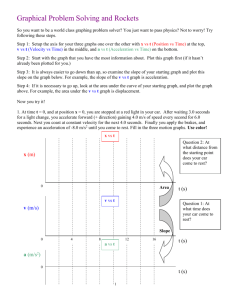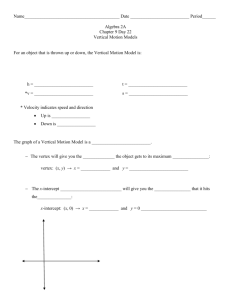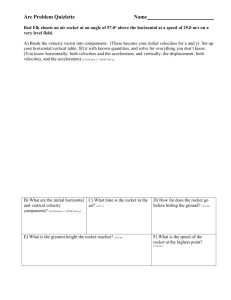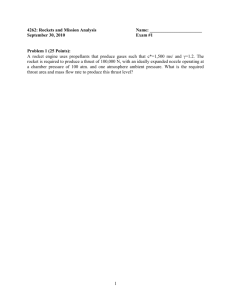The Mathematics of Rocket Propulsion
advertisement
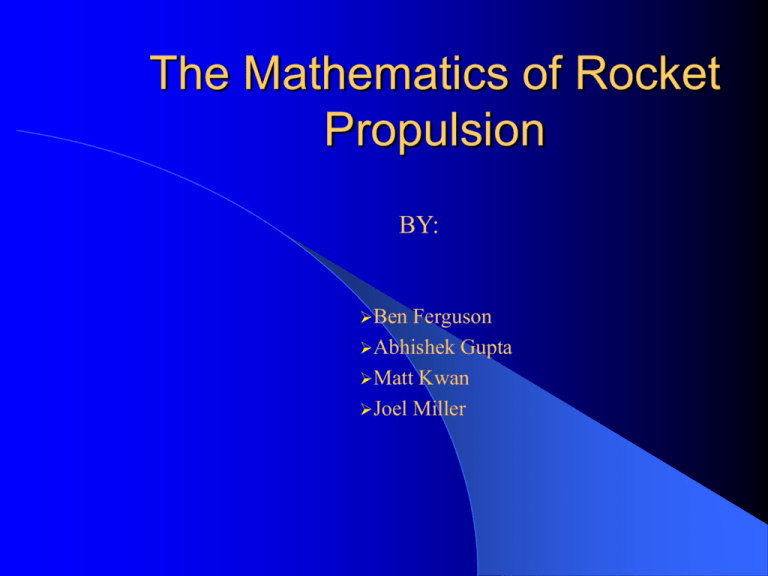
The Mathematics of Rocket Propulsion BY: Ben Ferguson Abhishek Gupta Matt Kwan Joel Miller Rocketry in the Contemporary Age Robert H. Goddard Werner Von Braun and the V-2 Rocket NASA Military Applications Amateur Rocketry Mathematical Relationships Critical to Understanding Rocket Propulsion Impulse Velocity Acceleration Impulse The impulse of a force is a product of a force and the timeframe in which it acts. Impulse is given by the integral: If a constant net force is present, impulse is equal to the average impulse: Remember that impulse is not a force or event, but a physical quantity. As such, it is often idealized for use in predicting the effects of ideal collisions as well as ideal engine output in rockets. Velocity/Acceleration Velocity is a measure of the rate of change in an object’s displacement from a certain point. Velocity is given in units of distance per unit time: Acceleration is a measure of the rate of change in an object’s velocity, or the derivative of the velocity function evaluated for a certain time ‘t’: Acceleration is expressed in units of distance over units of time squared: Ex: m/s^2 The kinetic energy of any object is defined as: Where m is the mass of the object and v is the velocity at time ‘t’ Finding The Acceleration of a Rocket Pi=Pf Pi=Mv , Pf= -dMUp + (dM+M)( v+dv); Where v Use Conservation of Momentum is velocity of rocket, Up is velocity of propellant, and M is mass of rocket U =(v+dv)-up ; Where up is velocity of propellant Substitute p relative to the rocket Mv= -dM(v+dv-up) + (dM+M)(v+dv) then use the distributive property Mv= -dM(-up) -dM(v+dv) + dM(v+dv) + M(v+dv) Finding The Acceleration of a Rocket Mv= -dM(-up) -dM(v+dv) + dM(v+dv) + M(v+dv) Mv= -dM(-up) + M(v+dv) Mv= dMup + Mv + Mdv 0= dMup + Mdv -dMup= Mdv divide both sides by dt -dM/dt up =Mdv/dt -dM/dt is rate of fuel consumption and dv/dt is acceleration a -dM/dt up is known as thrust T so… T=Ma Finding the Velocity -dMup= Mdv -dM/M up= dv integrate Remember that divide both sides by M ∫-up M-1dM = ∫dv; from Mi to Mf and vi to vf -up (lnMf -lnMi) = vf -vi up(lnMi -lnMf) = upln(Mi/Mf) so… ∆v = upln(Mi/Mf) Our Rockets Engine specs: C6-5: A8-3: Total Impulse Time Delay Max Lift weight Max thrust Thrust Duration Initial Weight Propellant weight 10.00 5 sec. 113g 3.4lbs 1.6 sec 25.8g 12.48g Total Impulse Time Delay Max Lift weight Max thrust Thrust Duration Initial Weight Propellant weight 2.5 3 sec. 85 g 2.4 lbs 0.5 sec 16.2 g 3.12 g (A-series engine used only for test flights) Liftoff!!! Works Cited •Canepa, Mark. Modern High-Power Rocketry. Baltimore, MD. Johns Hopkins University Press, 2003. •Culp, Randy. "Rocket Equations." 25 March 2005. 25 May 2006. <http://my.execpc.com/~culp/rockets/rckt_eqn.html> •Hickam, Homer. Rocket Boys. New York: Random House. 1998. •Nelson, Robert. "Rocket Thrust Equation and Launch Vehicles." June 1999. Applied Technology Institute. 25 May 2006. <http://www.aticourses.com/rocket_tutorial.htm> •"Rocket Motion." 4 March 1994. University of Pennsylvania. 25 May 2006. <http://www.physics.upenn.edu/courses/gladney/mathphys/subsubsection3_1_3_3.html> •Sutton, George P. Rocket Propulsion Elements. Montreal: John Wiley and Sons. 2001.

